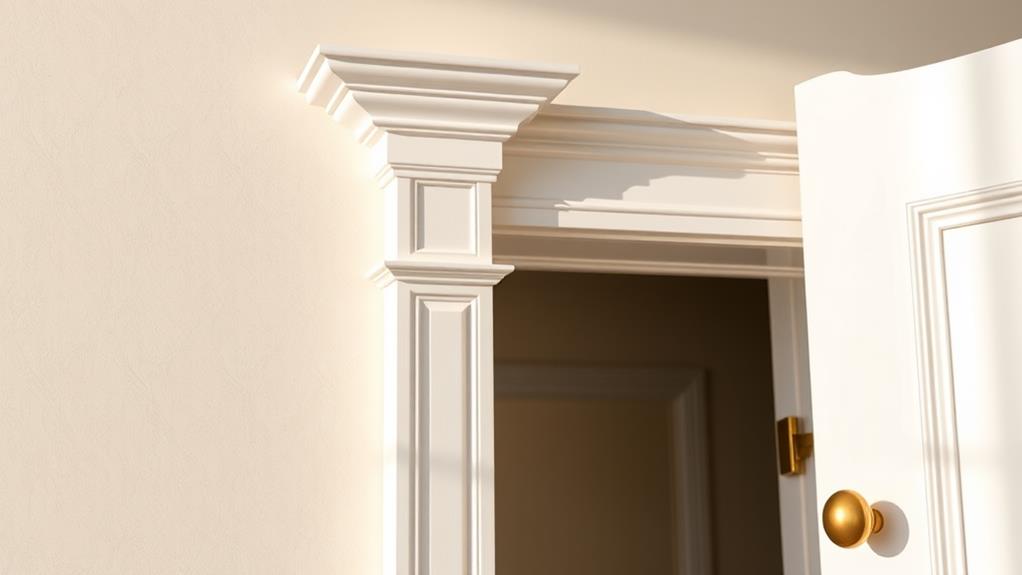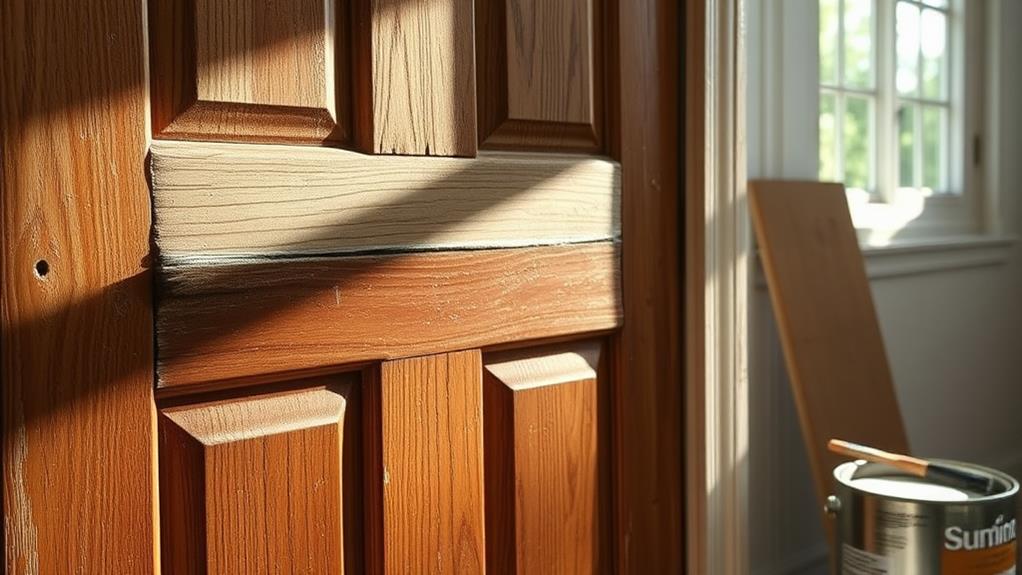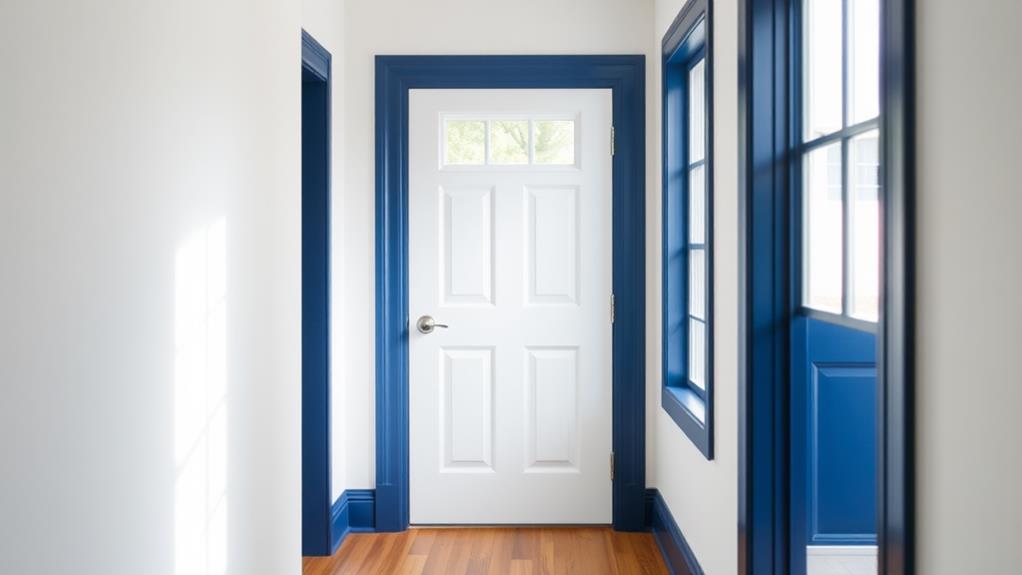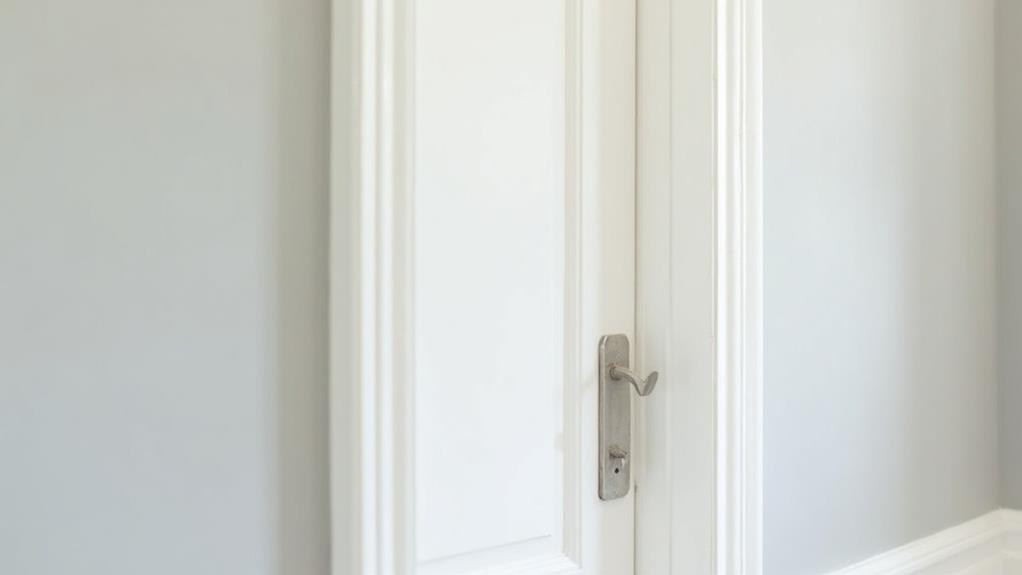Updating doors and trim offers an affordable way to dramatically enhance your home's interior. A fresh coat of paint can instantly transform the look, while new hardware modernizes doors and cabinets. Adding decorative molding or wainscoting creates architectural interest and depth. Refinishing wooden doors or replacing damaged trim improves both appearance and functionality. Painting trim in contrasting colors adds visual appeal, and upgrading to stylish door styles can elevate entire rooms. Even small changes to door frames, such as adding decorative molding or updating thresholds, can make a significant impact. These simple yet effective updates can breathe new life into your living spaces without breaking the bank.
Fresh Paint for Instant Transformation

One of the most cost-effective ways to revitalize doors and trim is through a fresh coat of paint. This simple update can dramatically transform the look of your interior spaces, creating a cleaner, more polished appearance. When selecting paint colors, consider the overall aesthetic of your home and choose shades that complement existing decor.
For a classic look, opt for white or off-white hues, which brighten rooms and create a timeless appeal. Alternatively, bold colors can add personality and visual interest to your space. Before painting, properly prepare surfaces by cleaning, sanding, and priming to ensure a smooth, long-lasting finish.
When painting doors, remove hardware and use a foam roller for large surfaces and a brush for details and edges. For trim, use painter's tape to protect adjacent walls and floors, and apply paint with a high-quality angled brush for precise application. Consider using semi-gloss or high-gloss paint for doors and trim, as these finishes are more durable and easier to clean than matte options. With careful preparation and application, a fresh coat of paint can breathe new life into your home's interior without breaking the bank.
Updating Door Hardware
Door hardware makeovers offer another cost-effective way to refresh your home's interior. Replacing outdated knobs, handles, and hinges can significantly transform the appearance of doors and cabinets throughout your home. When selecting new hardware, consider finishes that complement your existing décor, such as brushed nickel, oil-rubbed bronze, or matte black.
For a cohesive look, match the style of your new hardware to your home's architecture. Traditional homes benefit from ornate designs, while modern interiors pair well with sleek, minimalist options. Pay attention to the functionality of the hardware as well, opting for lever handles in areas where accessibility is a concern.
Don't overlook the impact of smaller details like strike plates and door stops. Updating these elements ensures a polished, well-coordinated appearance. For a budget-friendly alternative, consider spray-painting existing hardware to give it a fresh look. This DIY approach can be particularly effective for updating cabinet pulls and drawer knobs.
When installing new hardware, use a template to ensure precise placement and avoid damaging your doors. With careful selection and proper installation, updating door hardware can provide a noticeable improvement to your home's overall aesthetic at a fraction of the cost of more extensive renovations.
Adding Decorative Molding

Frequently overlooked, decorative molding can dramatically enhance the visual appeal of any room. This cost-effective update adds architectural interest, depth, and character to otherwise plain walls and ceilings. Crown molding, baseboards, chair rails, and wainscoting are popular options that can transform spaces with minimal effort and expense.
Crown molding, installed where walls meet the ceiling, creates a polished, finished look. It comes in various styles, from simple to ornate, to suit different interior design aesthetics. Baseboards, running along the bottom of walls, protect them from scuffs while adding a clean, defined edge. Chair rails, positioned horizontally at chair-back height, offer both decorative and functional benefits, preventing wall damage and visually dividing the space.
Wainscoting, typically covering the lower third of walls, adds texture and dimension. It can be achieved using traditional wood panels or more affordable alternatives like beadboard or faux panels. For a modern twist, consider applying picture frame molding to create geometric patterns on walls. This technique adds visual interest without overwhelming the space and can be customized to suit any room size or style.
Installing Wainscoting
Among the various molding options, wainscoting stands out as a versatile and impactful choice for enhancing interior spaces. This classic wall treatment typically covers the lower third of a wall, adding depth, texture, and visual interest to any room. Wainscoting comes in various styles, from traditional raised panels to more modern beadboard designs, allowing homeowners to match their existing décor or create a fresh aesthetic.
Installing wainscoting can be a cost-effective DIY project for those with basic carpentry skills. Pre-fabricated panels are available at most home improvement stores, simplifying the installation process. To begin, measure the wall space and cut the panels to size. Apply construction adhesive to the back of each panel and secure them to the wall using finishing nails. For a polished look, add a chair rail along the top edge of the wainscoting and baseboards along the bottom. Fill nail holes, sand smooth, and paint or stain the wainscoting to match your desired finish. This simple upgrade can transform plain walls into elegant, eye-catching features, elevating the overall ambiance of your home without breaking the bank.
Refinishing Wood Doors

A home's wooden doors often bear the brunt of daily wear and tear, accumulating scuffs, scratches, and faded finishes over time. Refinishing these doors can dramatically improve their appearance and the overall aesthetic of your home without the expense of replacement.
Begin by removing the door from its hinges and hardware. Sand the surface thoroughly to remove old finish and imperfections, progressing from coarse to fine-grit sandpaper. Clean the door with a tack cloth to remove dust.
For a natural look, apply wood stain in your desired shade, following the manufacturer's instructions. Allow proper drying time between coats. Alternatively, use paint for a more dramatic change or to match your home's color scheme. Apply primer if needed, then use a foam roller or brush for even coverage. Once dry, add a protective clear coat for durability.
Refinishing interior doors typically takes a weekend per door, making it a manageable DIY project. For exterior doors, consider weather resistance when selecting finishes. This cost-effective update not only enhances your home's appearance but also extends the life of your wooden doors, providing a fresh look for years to come.
Replacing Damaged Trim
While refinishing doors can breathe new life into your home, addressing damaged trim is equally important for a polished look. Damaged trim can detract from the overall appearance of a room and potentially expose your walls to moisture or pests. Replacing trim is a cost-effective way to update your space and protect your home's structure.
Begin by carefully removing the damaged trim using a pry bar and utility knife. Measure the length of the trim and purchase a replacement that matches the style and material of the existing trim. Pre-paint or stain the new trim before installation to ensure a professional finish. Cut the new trim to size using a miter saw for precise angles at corners. Secure the trim to the wall using finishing nails and a nail gun, being careful to avoid hitting any electrical wires or plumbing. Fill nail holes with wood putty and touch up the paint or stain as needed.
For a cohesive look, consider replacing all the trim in a room, even if only some pieces are damaged. This ensures uniformity in color and wear, creating a fresh, updated appearance throughout the space.
Painting Trim Contrasting Colors

To create a striking visual impact in your home, consider painting your trim in contrasting colors. This technique can dramatically transform the look of a room without requiring significant investment. Choose a trim color that complements your wall color while providing enough contrast to make architectural features stand out. For a classic look, opt for white trim against darker walls, or for a bolder statement, try deep, rich hues against light walls.
Before painting, properly prepare the trim by cleaning, sanding, and priming it. Use high-quality paint brushes or rollers designed for trim work to ensure a smooth finish. Semi-gloss or high-gloss paint is typically recommended for trim, as it's more durable and easier to clean than flat finishes.
Consider painting door frames, baseboards, crown molding, and window casings in the same contrasting color for a cohesive look throughout the space. For added interest, you can even paint interior doors in the same contrasting shade as the trim. This approach not only refreshes the room's appearance but also highlights architectural details and adds depth to the overall design.
Upgrading Interior Door Styles
Interior doors play a significant role in defining the character of your home, and upgrading their style can have a profound impact on your living spaces. Replacing outdated hollow-core doors with more substantial options can instantly elevate the look and feel of a room. Consider switching to solid wood doors for a classic, high-end appearance or opting for glass-paneled doors to enhance natural light flow between rooms.
For a cost-effective alternative, refacing existing doors can yield impressive results. Adding decorative molding or trim to flat doors creates a custom, paneled look without the expense of full replacement. Painting doors in a bold, contrasting color or applying a wood stain can also dramatically change their appearance. Another option is to install new hardware, such as stylish doorknobs, hinges, or handles, which can modernize the overall aesthetic.
For those seeking a more dramatic change, consider installing sliding barn doors or French doors in place of traditional swinging doors. These alternatives not only serve as functional room dividers but also act as striking architectural features, adding visual interest and character to your home's interior.
Enhancing Door Frames

Beyond the doors themselves, door frames play a crucial role in the overall appearance of your entryways. Enhancing these often-overlooked elements can significantly elevate the aesthetic of your interior spaces. One cost-effective approach is to add decorative molding to existing frames, creating a more elegant and sophisticated look. Crown molding at the top of the frame or fluted casing along the sides can transform a plain opening into an architectural feature.
Painting door frames is another simple yet impactful update. Contrasting colors between the frame and the door can add depth and visual interest, while matching colors create a sleek, cohesive appearance. For a more dramatic change, consider widening the frame with additional trim pieces to create a more substantial presence.
Installing door frame corner blocks is an easy way to add character and detail. These decorative elements sit at the corners of the frame, providing a finished look and concealing any imperfect miter joints. Finally, updating the threshold and weatherstripping not only enhances the frame's appearance but also improves energy efficiency and reduces drafts, making this a functional as well as aesthetic improvement.
Frequently Asked Questions
How Do I Soundproof Interior Doors Without Replacing Them?
To soundproof interior doors without replacement, consider adding weatherstripping around the edges, installing door sweeps, applying mass-loaded vinyl, or hanging sound-absorbing curtains. Filling gaps with acoustic caulk and using foam panels can also improve sound insulation.
Can I Install Smart Locks on Older Doors?
Yes, smart locks can often be installed on older doors. Most models are designed to replace existing deadbolts, making them compatible with various door types. However, ensure your door's thickness and existing hardware are suitable for the chosen smart lock.
What's the Best Way to Childproof Door Handles and Trim?
According to the CDC, over 200,000 children visit emergency rooms annually due to home injuries. To childproof door handles and trim, consider installing childproof door knob covers, edge guards, and corner protectors. These affordable solutions effectively prevent accidents and injuries.
How Do I Fix Squeaky Door Hinges Permanently?
To permanently fix squeaky door hinges, start by removing the hinge pins and applying a lubricant like silicone spray or white lithium grease. Clean old debris, reinsert pins, and wipe away excess. If necessary, tighten loose screws or replace worn hinges.
Are There Eco-Friendly Options for Door and Trim Materials?
Yes, eco-friendly options for door and trim materials exist. Consider using reclaimed wood, bamboo, or sustainably harvested timber. Other environmentally conscious choices include recycled plastic composites, cork, and fibreglass made with natural fibres and low-VOC resins.
Conclusion
In conclusion, doors and trim offer a wealth of opportunities for cost-effective home improvements. From a fresh coat of paint to upgraded hardware and decorative moldings, these elements can breathe new life into living spaces. Like the icing on a cake, well-executed door and trim updates can elevate the entire aesthetic of a home. By focusing on these often-overlooked features, homeowners can achieve significant visual impact without breaking the bank, making their living spaces more inviting and personalized.

